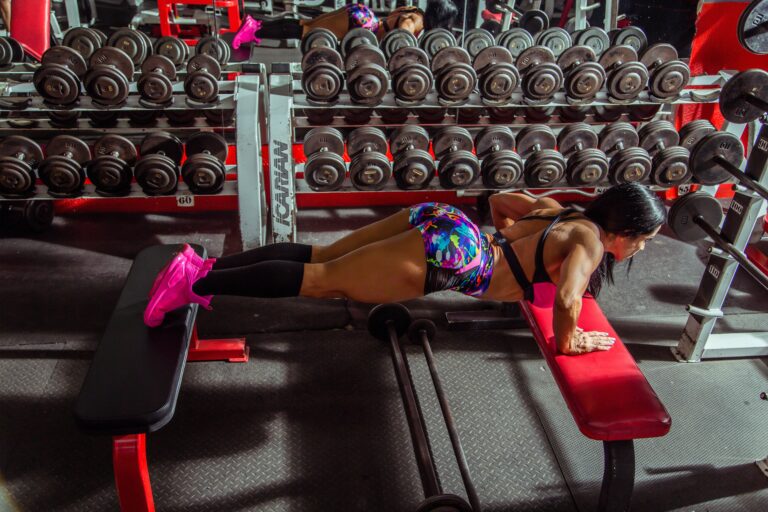Building lean muscle has many health benefits, such as a faster metabolism and stronger bones. It also makes you look better. On the other hand, burning fat improves overall health and can reduce the risk of diabetes and heart disease. If you’re prepared to take your fitness to the next level, continue reading to learn about these tried-and-true methods for building lean muscle and burning fat.
Proper Nutrition
Proper nutrition is a must for building lean muscle mass and burning fat. A well-balanced diet gives your body the essential nutrients it needs to work well and grow muscles. Instead of just taking supplements, getting various nutrients from whole, unprocessed foods is necessary.
Protein is the primary building block of muscle tissue, so getting enough of it is crucial for building muscle. Depending on your goals and activity level, aim for 1–1.5 grams of protein per pound of body weight per day. Protein-rich foods include chicken, beef, fish, eggs, dairy products, legumes, and soy products like beans and tofu.
It is also essential to eat enough carbohydrates and fats in addition to protein. Carbohydrates give you the energy to work out and refill glycogen stores in your muscles, while fats help make hormones and keep cells working. Because of this, eating more complex carbs, like whole grains and vegetables, and healthy fats, like avocados, nuts, and olive oil, is essential.
Timing and frequency of meals can also affect muscle growth and fat loss. Most people should eat every three to four hours to keep their metabolism and energy level steady. This may include three main meals and two or two snacks. In addition, eating before and after working out is crucial so your muscles can grow and heal.
It is critical to consider portion size and the quality and quantity of nutrients. If you eat more calories than your body needs, you may gain weight, while eating too few calories can stop your muscles from growing. Keeping a food journal or using a nutrition tracking app can help you meet your nutrient and calorie requirements.
In conclusion, proper nutrition is crucial for building lean muscle and burning fat. Eating a well-balanced diet with the right amounts of protein, carbohydrates, and fats and paying attention to when and how often you eat can help your muscles grow and lose fat.
Resistance Training
Resistance training is an excellent way to build lean muscle and lose body fat. Weights or other forms of resistance are vital to strengthening and challenging muscles. Weightlifting, bodyweight exercises, and resistance bands are all examples of resistance training.
Weight lifting, also called weight training or strength training, uses dumbbells, barbells, and other weights to do exercises like squats, bench presses, and deadlifts. This form of resistance training helps gain muscle mass and strength.
Bodyweight exercises, such as push-ups, squats, and lunges, use your body weight as resistance to strengthen and challenge the muscles. This type of resistance training is easy to do and requires no special equipment.
Resistance bands are an alternative resistance training option. These elastic bands come in various resistance levels and can be used for multiple exercises.
It is important to start resistance training at a level that is right for your current fitness level and gradually increase the intensity and difficulty over time so that you can set realistic goals and make progress. This can be accomplished by increasing the weight lifted, the number of
repetitions or sets, or the rest time between groups. To repair and grow muscles, adequate rest and recovery between workouts are essential.
Mixing up your workouts is also essential if you want to keep progressing and avoid hitting a plateau. This may involve varying the exercises, their order, the number of sets and repetitions, and the weight used. Additionally, changing your workouts can prevent boredom and keep you motivated.
In conclusion, resistance training is a great way to build lean muscle mass and reduce body fat. You can change your body and reach your fitness goals by challenging and strengthening your muscles with weights or other forms of resistance, setting realistic goals, and keeping track of your progress. Additionally, incorporating variety into your workouts can help you avoid plateaus and stay motivated.
High-Intensity Interval Training is the third technique (HIIT)
HIIT is a cardio workout consisting of short bursts of hard work followed by short breaks. HIIT is an excellent way to lose fat and get fitter.
One of the best things about HIIT is that it can be completed in less time than conventional steady-state cardio. Studies show that HIIT can be just as good as cardio for improving fitness and burning fat, but it takes longer. In addition, HIIT has been shown to increase the body’s metabolism, which means that you continue to burn calories at a higher rate after the workout has ended.
You can use HIIT workouts to fit your fitness level and personal tastes. Examples of HIIT exercises include:
Sprint intervals: Interspersing short periods of all-out sprinting with periods of rest
Circuit training is a series of strength and cardio exercises with little rest in between.
Tabata training: A type of HIIT in which an exercise is done at maximum intensity for 20 seconds, followed by 10 seconds of rest, and then repeated for a total of 4 minutes.
You can start adding HIIT to your fitness routine by performing 1-2 HIIT workouts per week in addition to regular resistance training and cardio. As you get better, you should slowly make your HIIT workouts harder and longer and give yourself enough time to rest and recover between sessions.
In conclusion, HIIT is an effective fat loss and overall fitness improvement method. By short, alternating periods of intense activity with periods of rest, you can effectively increase your metabolism and continue to burn calories after your workout. HIIT is also easy to adjust to your fitness level and preferences, and you can add it to your fitness routine 1-2 times a week.
Rest and Sleep
Rest and recovery are indispensable for building lean muscle and burning fat. When you train, you stress your strengths and deplete your energy stores. During periods of rest and recovery, the body repairs and rebuilds muscles and adjusts its energy stores and metabolism to meet the demands of training. Therefore, muscle growth and overall fitness progression require sufficient rest and recovery.
There are numerous methods to promote rest and recovery, including:
Getting enough sleep: Adults should aim for seven to nine hours of sleep per night so that their bodies can repair and recover.
Active recovery is when you do low-intensity activities like stretching, foam rolling, and light cardio to improve blood flow and help your muscles heal.
For the muscles to repair and grow, it is necessary to take breaks between workouts. This may include a full day of rest or a reduction in the frequency and intensity of your activities.
Appropriate nutrition: consuming adequate nutrients, particularly protein, can aid muscle recovery and growth.
Enhancing sleep quality is another crucial aspect of recovery. There are a variety of ways to improve your sleep:
Keep a regular sleep schedule. Going to bed and getting up at the same time every day can help the body’s natural sleep-wake cycle work better.
Create a conducive sleeping environment: Keep your bedroom calm, dark, and quiet, and refrain from using electronic devices at least one hour before bedtime.
Before bed, prepare your body and mind for sleep by engaging in relaxing activities such as reading, meditation, or a warm bath.
In conclusion, you need to get enough rest and recovery time to build lean muscle and burn fat. You can help your muscles grow and heal by getting enough sleep, actively recovering, taking breaks between workouts, and eating the right foods. Enhancing sleep quality can also aid in recovery and general health.
Attitude and Consistency
To reach your fitness goals, keep a positive attitude and be consistent with your training and eating. Your mindset dramatically affects how you try to reach your goals and can make the difference between success and failure.
Here are some ways to keep a positive attitude and stay on track with your fitness journey:
Set goals that are realistic and clear. Setting realistic and clear goals can help you stay motivated and on task. Focusing on progress rather than perfection and celebrating small victories is essential.
Determine what works best: Try out different ways to exercise and eat to find out what works best for you and your body.
Compare yourself only to yourself: It’s easy to fall into the trap of comparing yourself to others, but it’s important to remember that everyone’s journey is unique, and progress is not always linear.
Do not become disheartened by setbacks: Reversals are a normal part of the process, and it’s important to see them as chances to learn and grow rather than failures.
Consistency is also essential for reaching fitness goals. You need to be consistent with your training and nutrition and work on these things every day. This can include setting aside time for workouts, meal planning, and finding ways to make healthy habits more convenient and lasting.
To reach your fitness goals, keep a positive attitude and be consistent with your workouts and diet. By setting goals you can reach, finding out what works for you, avoiding comparisons, and staying calm when things don’t go as planned, you can change your body and get to the level of fitness you want. Long-term success also requires that you be consistent in your efforts.
Conclusion
In conclusion, building lean muscle and burning fat requires proper nutrition, resistance training, cardio exercise, recovery and sleep, a positive mindset, and consistency. You can effectively transform your body and achieve your fitness goals by implementing these techniques and maintaining consistency in your efforts.
Proper nutrition is essential for supporting muscle growth and recovery. Muscle growth is achieved by eating a balanced diet with the right amounts of protein, carbohydrates, and fats and paying attention to when and how often you eat. Weights, bodyweight exercises, or resistance bands can be used for resistance training, which helps to build lean muscle mass and strength. High-intensity interval training, or HIIT, is a great way to lose fat and improve your overall shape. You can do it 1-2 times a week as part of your everyday routine. Rest and recovery are essential for muscle growth and progress, like getting enough sleep and being active. Lastly, keep a positive attitude and be consistent with your training and eating to reach your fitness goals.
By implementing these strategies, you can work towards a lean, muscular physique and improve your overall health and well-being. Remember to be patient and consistent in your efforts, and acknowledge your progress.




